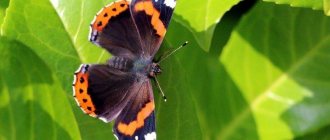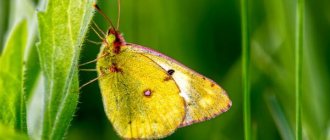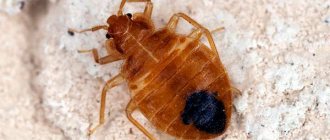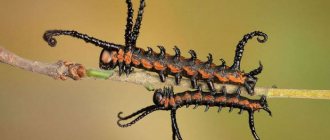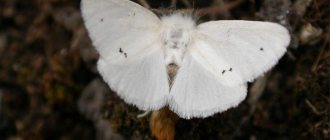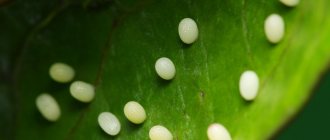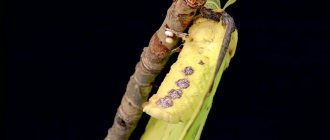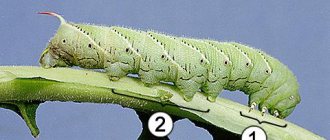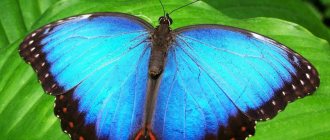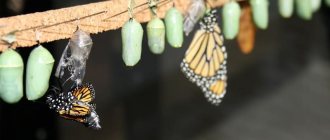Get ready for a journey into the colorful world of insects! You will see unusual butterflies and caterpillars common in the Moscow region, learn to identify them by their external signs and simply get aesthetic pleasure!
When we talk about the benefits of butterflies, we most often mean the properties of adult individuals. Thus, these insects are able to pollinate plants and attract birds to the garden. And if we mention harm, then here we are talking about the caterpillar stage, when the insect actively feeds on plants and can harm garden plantings. The butterflies themselves feed on nectar and are absolutely safe for plant health. Therefore, we will agree in advance that when we call a butterfly “harmful,” we mean its caterpillars.
Now let's take a closer look at the most common fluttering insects that you can find on your site, and determine which of them are useful and which are harmful!
Admiral - butterfly with stripes
Vanessa atalanta, wingspan 50-65 mm
The admiral is easy to recognize: there are red stripes on both sides of his wings. According to one version, it was thanks to this color that the butterfly got its name, because Russian admirals used to have ribbons over their shoulders and red stripes on their trousers. The lower wings of the insect are also decorated with red stripes, on which black dots are clearly visible. The edges of the wings are wavy.
You can meet such a beautiful butterfly not only in Russia, but also in North Africa, North America and even New Zealand. The admiral usually goes to southern countries to spend the winter, but sometimes hides under the bark of trees and remains there until spring. Previously, the admiral was included in the Red Book of Russia, but now the population has recovered.
animalreader.ru
It is not so easy to recognize the admiral's caterpillar as a future butterfly. Dark color, yellow dots on the sides of the body and frightening spikes - the insect is perfectly protected from birds and knows how to camouflage itself. It can be found from May to August on the leaves of nettles, hops and thistles.
How to attract an admiral butterfly. The Admiral loves thistles, asters and blackberries, and at the end of the season he is not averse to eating cracked plums and pears, especially if they have fermented. Place some fruit in a bowl and butterflies will flock to the smell. And to see the caterpillars, plant nettles on the site, which will also be useful as plant food.
The ancient Indians believed that if you catch a butterfly, whisper a cherished wish to it and release it into the wild, it will certainly come true. Try it!
Are caterpillars a separate species of insect?
Caterpillars are not representatives of a separate species, order or suborder of insects. This is one of the stages of development of butterflies - insects belonging to the order Lepidoptera.
A caterpillar is a butterfly larva that hatches from an egg and eventually develops into a pupa, from which a beautiful butterfly actually emerges.
Caterpillar
Until the caterpillar turns into a butterfly, the larva faces many dangers. Caterpillars use a variety of defenses to survive. Some are frightened by the bright colors, others by the unpleasant smell, and still others are completely poisonous.
Hawthorn - beautiful and treacherous
Aporia crataegi, wingspan 50-65 mm
Hawthorn can often be found in gardens in the Moscow region. This beautiful butterfly with white wings decorated with black veins flies from apple tree to rosehip, from rowan to plum, from grape to pear to lay its eggs, from which voracious caterpillars will soon emerge. Hawthorn is a “relative” of the famous cabbage. Prefers wetlands and easily travels long distances in search of food and nesting sites.
nature.baikal.ru
Hawthorn caterpillars are covered with thick hairs and can gnaw an entire bush or tree in a short time. They grow slowly, so they make nests in trees for the winter. If leaves entangled with mulberry threads appear on the branches, rest assured that the hawthorn has settled in your garden!
How to deal with hawthorn and its caterpillars. You can place hunting belts on trees and put up birdhouses to attract birds. In early spring, it is worth spraying the plants with a solution of copper sulfate (100 g per 10 liters of water) with the addition of 500 g of urea. If there are a lot of pests, use insecticides: Alatar, Fatrin, Kinmiks, etc. Carry out the treatment during bud break, when the caterpillars emerge from their winter nests, or in the summer after the caterpillars hatch from their eggs.
Cabbage is a dangerous pest of cabbage heads
Pieris brassicae, wingspan – 45-63 mm
Cabbage grass, or cabbage white, is familiar to every summer resident. You can find it in beds with cabbage, turnips, turnips and other cruciferous crops. The butterfly is fussily looking for a place to lay eggs, from which yellow-green caterpillars will soon appear. During the season, one individual lays up to 300 eggs!
Unprepossessing in appearance, the white hare terrifies with its appearance. You should especially be wary of females, the main difference of which is the black spots on the upper wings.
The voracious caterpillars of the white butterfly eat the leaves and prevent the head of cabbage from forming. After a while, only the veins remain from the leaf. When the food runs out, the pests crawl to new plantings.
How to deal with cabbage and its caterpillars. Safe methods include hand-picking caterpillars and catching butterflies. You can also plant marigolds, marigolds, mint or sage between the rows, which will repel pests. A good way is to cover the cabbage with a mosquito net and agro-canvas so that butterflies cannot lay eggs. Folk remedies will help by spraying 2 tbsp. mustard and 1 tsp. ground red pepper per 10 liters of water. And if there are a lot of insects, use Fitoverm, Karbofos, Actellik or another insecticide.
Control of caterpillar pests
There are three groups of ways to combat caterpillars devouring crops of vegetables, fruits and vegetables.
Mechanical method - when caterpillars are collected manually, their overwintering clutches are cut off.
One of the most effective methods is to catch them using adhesive-coated belts or traps filled with bait liquid.
The biological method is when birds are attracted to agricultural fields and orchards and eat caterpillars, arranging feeders and birdhouses for the birds.
Caterpillar snake
The chemical method is the most effective, but after some time the caterpillars get used to the composition of the drugs and stop dying, so the chemical method is alternated with the biological one.
In dacha conditions, to combat the invasion of caterpillars, infusions of herbs are used - black henbane (it works well against the caterpillars of the ubiquitous cabbage butterfly), hemlock (it is effective against caterpillars attacking fruit trees), peppermint, and elderberry.
Urticaria - a connoisseur of birch sap
Aglais urticae, wingspan – up to 50 mm
You've probably seen this butterfly more than once, but you couldn't even imagine that the offspring of this luxurious beauty feed on stinging nettles! A special sign of urticaria is large black spots on dark orange wings. The hind wings are covered with small blue spots. The insect feeds on nectar of various flowers, and also does not refuse birch sap.
nasekomus.ru
One clutch of wren can contain up to 150 eggs, from which black, hairy caterpillars emerge. They gradually begin to eat the nettles, and at its top they build a nest of cobwebs for shelter from bad weather. After numerous molts, the caterpillar becomes yellow-black and is ready to pupate.
How to attract hives. The answer is obvious - plant nettles! But if you don’t want to see this weed in your summer cottage, try pouring a little birch sap into flat containers to attract insects. And plant lavender, oregano, echinacea, David's buddleia, spirea, bird cherry and other aromatic plants in your flower beds.
- What to plant in a flower garden to fill the garden with an unforgettable aroma
Do you want to plant fragrant flowers on your property? Then take a look at our selection!
The benefits and harms of butterflies
The benefit or harm that butterflies bring largely depends on what stage of development the insects are at. Thus, the vast majority of caterpillars are pests that destroy both agricultural and wild plants. But adult butterflies participate in the pollination of many plants.
For reference! Many scientists are of the opinion that the role of butterflies in the pollination process is greatly exaggerated. When they drink nectar, they prefer not to get their paws dirty with pollen, which means they don’t transfer it to other plants.
Larvae and adult butterflies are food for birds and insectivorous animals. Some varieties of caterpillars feed on insect pests. Speaking about the benefits of butterflies, one cannot fail to mention the silkworm, which is used in the production of natural silk.
Well, of course, one cannot downplay the aesthetic significance of butterflies in human life. They help to understand and enjoy the beauty of nature.
Willow ribbonwort - twilight guest
freenatureimages.eu. Catocala electa, wingspan – 65-88 mm
The second name of this butterfly is willow ribbon. The insect leads a crepuscular lifestyle, so you are unlikely to see it during the day. The butterfly's front wings are gray and inconspicuous, but the lower wings are bright red with black edging and spots in the middle. Moreover, in males the raspberry shade predominates, and in females it is red. The Ribbonwort can also be seen in the fall. It is most often found near bodies of water, in meadows and wetlands. It feeds on tree sap.
pyrgus.de
Caterpillars of the willow tapeworm are perfectly camouflaged. The yellow-gray body is covered with small black dots, the head is brown. The insect feeds on willow and poplar leaves, so it does not harm garden crops. But if you have a willow growing on your site, be vigilant.
How to attract a ribbon girl. It would seem that the insect is nocturnal - why attract it? You can do this at least just to see this amazing butterfly. In the evening, turn on a flashlight or other artificial light source - and the ribbon fly will come to visit you.
How to raise an insect
It is possible to create an ideal living environment, but you need to consider a few important things:
- Take a clean food container.
- Fold the paper towel and place it at the bottom of the container.
- Place a regular dry stick or popsicle stick (or two) into the container.
- Carefully place the caterpillar into the container. If it is on a sheet, place the sheet with it.
- If the insect was on the plant and is still eating, store fresh leaves in a container until pupation.
- If the insect sways, it needs to be cleaned. You may need to replace the paper towel from time to time.
- If an insect crawls into a paper towel and disappears, it is probably hiding before pupating.
- Once it pupates, the butterfly will hatch.
The process of turning a larva into an adult butterfly takes a long time, and during most of this period nothing seems to happen. It's even difficult to tell whether the caterpillar is alive or not. The pupal stage can last weeks and often months—many species pupate throughout the winter and hatch the following summer.
Lemongrass is a long-liver in the world of butterflies
Gonepteryx rhamni, wingspan – 52-60 mm
Lemongrass, or buckthorn, is a rather inconspicuous-looking butterfly from the white butterfly family. Small dots are placed in the center of its wings, and the wings themselves imitate the shape of leaves on a tree. Nature has done its best so that these insects can hide from their enemies!
Males have a richer wing color than females. In the latter, the color of the wings is predominantly greenish-white. The development cycle of one individual takes about a year, which is a rare phenomenon in the world of butterflies. Therefore, lemongrass can safely be called a long-liver.
macroid.ru
Lemongrass lays 1-2 eggs on buckthorn leaves. Then green, smooth, slightly flattened caterpillars appear. Despite their great appetite and fastidiousness, insects do not cause much harm to trees.
How to attract lemongrass. Mostly butterflies feed on the nectar of dandelion, meadow cornflower, thistle, but they will not refuse cultivated plants. It is better to fight weeds that attract lemongrass in your summer cottage.
- How to get rid of weeds - the secrets of “clean” beds
Weed control is the main headache of all summer residents. Let’s figure it out together how to suppress the growth of weeds effectively and easily.
Types of butterfly eggs
Butterfly eggs come in various shapes - round, flattened, oval, spindle-shaped, smooth or with a cellular surface, covered with spines or ribs. The color of the eggs is also different, most often whitish, light green or yellow, in addition, brownish, brownish-violet, reddish. The eggs of many species change color as they develop.
The manner in which eggs are laid may differ among different species of butterflies. Eggs can be laid one at a time or several at a time, or in large groups, up to several hundred in one clutch. Eggs can be laid on leaves, stems, flowers, fruits of plants, in cracks in tree bark, on soil, lichens, and on dry plant remains. After laying, females of some species cover their eggs with hairs from their abdomen.
Malinnitsa is a modest record holder
commons.wikimedia.org by Charles J Sharp. Callophrys rubi, wingspan 26-28 mm
The raspberry and the raspberry blueberry are the same butterfly from the genus Greenfinch. It is not easy to notice it, because... the outside of the insect is brown and the inside is green. In addition, the butterfly is small and almost always keeps its wings folded for camouflage. You can meet her not only at the dacha, where she flies for flower nectar, but also in swamps and meadows. Raspberries are common in the temperate zone of Eurasia. The butterfly's habitat reaches the Polar Urals, and in the Alps it sometimes rises to a height of up to 1800 m!
insectamo.ru, author: Ponomarev A. G.
Raspberry caterpillars have a fairly rich “menu”, which includes leaves of blueberry, heather, birch, gorse, buckthorn and other plants. What about raspberries, you ask? Alas, raspberry caterpillars really will not refuse raspberry and currant leaves. But despite their food preferences, they are rare on these plants. Insects are sensitive to chemicals, so they prefer to stay away from summer cottages. In addition, this species is quite rare in nature.
Some blueberry caterpillars are able to pass themselves off as ant larvae. As a result, the ants feed the caterpillars, and the latter, without hesitation, also eat the eggs and larvae of their benefactors.
How to attract raspberries. The raspberry tree is not one of those butterflies that will circle brightly over a flower bed. But if you have clover, sweet peas or vetch, she may come briefly to collect sweet nectar.
Caterpillar stage
The butterfly larva is a worm-like caterpillar. She has a pronounced gnawing mouthparts. The caterpillar has a special secretion that hardens in air and forms a silk thread. The larvae are mainly phytophagous, that is, their food is flowers, leaves and fruits of plants.
There are also types of caterpillars that eat the larvae of ants, aphids and mealybugs. These species are predators. On the body of the caterpillar there are 10 abdominal segments with five pairs of thick legs and 3 thoracic segments with three pairs of jointed legs. The body has smooth skin with spikes, warts and hairs. Caterpillars usually live on the ground, trees, and bushes, but some of them, such as broad-winged moths, can live underwater. They can be divided into two large groups:
- caterpillars prone to a free lifestyle;
- caterpillars prone to a hidden lifestyle.
The latter construct portable cases from silky thread in which they live. They carry it on themselves and hide in it. Also, caterpillars build themselves a cigar-shaped cover from leaves in the form of a shelter, having previously secured it with silk thread. The development cycle of a butterfly at this stage can last several years. Caterpillars in northern latitudes may enter a state of diapause until next summer. For example, the life cycle of the larvae of the seaweed, which lives in Greenland, can last up to 14 years.
Swallowtail - Queen of Butterflies
Papilio machaon, wingspan – 64-95 cm
It’s hard not to notice such a butterfly! Swallowtail attracts attention with its large size and bright color. The butterfly got its name from the name of a mythological doctor who participated in the Trojan War. A special feature of the swallowtail is the “tails” up to 10 mm in length on the hind wings.
Swallowtail is found all over the world: in Europe, Asia, North America and North Africa. The butterfly population in the middle zone suffers from fires and trampling of meadows. The species is listed in the Moscow Red Book.
The bright swallowtail caterpillars resemble fantastic creatures. Immediately after birth, they begin to feed. In the Moscow region, insects prefer umbrella crops: hogweed, carrots, parsley, fennel and dill. If a caterpillar gets into a garden bed, it can quickly destroy the above-ground parts of the plants. But this happens extremely rarely, because... The swallowtail practically does not fly to summer cottages.
How to deal with swallowtail caterpillars. Carefully remove them and take them outside the site, planting them on some kind of umbrella crop. Be careful, the “horns” of the caterpillars secrete a caustic liquid, so it is better not to pick up the insect with your hands, but tear it off along with a piece of the plant on which it sits.
Life cycle
Different types of caterpillars live from several weeks to several years. For example, the larvae of butterflies living in the north do not have time to develop during the short summer season; they hibernate until the next one - the horned butterfly, whose habitat is the Arctic, exists as a caterpillar for an average of 13 years.
During the life cycle, amazing metamorphoses occur with caterpillars - from an increase in size and a change in color to the transformation from an individual with bare skin to a furry one and vice versa.
When the life cycle comes to an end, the caterpillars pupate, then butterflies hatch from the pupae.
Peacock's eye - the most picturesque butterfly of the middle zone
Aglais io, wingspan up to 62 mm
This butterfly will not leave any summer resident indifferent! The insect will decorate any flower garden and its offspring will not cause any harm to the garden. The round spots on the front and hind wings of the butterfly are very reminiscent of the spots on the tail of a peacock. With the help of such a cunning device, the peacock's eye often confuses birds that would like to feast on the butterfly.
dic.academic.ru
The peacock eye caterpillar is not so noticeable, although its black spines can also scare off enemies. Black caterpillars live in large colonies of up to several dozen individuals. They mainly prefer to eat nettles, thistles or hops, and less often – willow and raspberries.
How to attract a peacock eye. These butterflies are excellent pollinators. To attract them to the garden, plant flowers in shades of red, pink, orange or yellow in your flower bed. And also plant some nettles in the area.
How to control peacock eye caterpillars. An invasion of caterpillars can damage the raspberry tree, but if in the spring you treated the plantings with insecticides as standard, do not worry about the safety of the crop. It is easier to remove pest colonies manually.
Habitat
For most species of caterpillars, the habitat is the surface of the earth, some species live in water, for example, the caterpillars of broad-winged moths, and the larvae of the Hawaiian moth can exist both in the air and under water.
According to the conditions of existence, these insect larvae are divided into two categories - hiding and leading a lifestyle in plain sight.The hidden ones are represented by:
- leafworms - these caterpillars live on trees, existing in twisted leaves;
- frugivores - live in fruits and vegetables;
- by drillers - the habitat of tree trunks and roots;
- miners - the habitat is foliage, branches, fruit and vegetable peels, plant buds - caterpillars make passages;
- gall formers - they cause damage to plant tissues and the appearance of new growths on them;
- living underground;
- aquatic – the habitat is bodies of water.
Leading a free lifestyle, they openly exist on plants; these are mainly caterpillars of large varieties of butterflies.
Mother of pearl - the enemy of apple trees, blackberries and raspberries
Argynnis paphia, wingspan up to 75 mm
The pearlwort is a fairly large daytime butterfly with an unusual spotted color. The name of the insect was given because of the iridescent greenish-silver spots by which butterflies recognize individuals of their species. In warm weather, you can see flocks of pearlworts busily flying over the flower beds. These lepidopterans are also found along roadsides, in clearings and near rivers. There are many subspecies of Argynnis paphia, each of which feeds on specific crops.
molbiol.ru
Most often found in the country are large mother of pearl. Food plants for its caterpillars are apple trees, blackberries, raspberries, and violets. The body of the larvae is covered with many villi.
How to deal with mother of pearl and its caterpillars. There are different ways to protect plants from caterpillars. The simplest is to install trapping belts or pheromone traps and inspect them regularly. Regular removal of curled leaves and attracting birds will also help. It is better to choose biological drugs: Fitoverm, Bitobaxibacillin, Entobacterin, etc.
Pupa stage
Butterflies have sedentary pupae. The main type characteristic of Lepidoptera is glued. In some families, such as cocoon moths, the pupa lives inside a cocoon that was woven by a caterpillar. The shape is cylindrical, sometimes round. - from light colors to dark ones with the presence of stripes and inclusions. Usually the pupa is located inside glued leaves on the trunks and flowers of plants with the rudiments of the abdomen, wings, legs and proboscis already clearly visible. At this stage of development there is no nutrition.
Meadow pestle is a poisonous insect
Zygaenidae, wingspan 16-38 mm
Groups of pests often flutter over flower beds in sunny weather. Insects are easy to recognize: they have rounded red spots on their dark blue or green wings. In addition, unlike other butterflies, the wings of the meadow moth are folded like a roof, like those of moths. If a butterfly is caught, it will begin to secrete repellent foam. In nature, no one hunts a butterfly. It is poisonous and itself very resistant to poisons.
Caterpillars of moths are densely covered with warts, from which small bristles protrude. Body color: yellow-green with a scattering of black spots. Caterpillars can also secrete protective substances, so it is better not to handle insects with your bare hands. They feed mainly on clover and grasshoppers.
How to attract meadow moth. Plant clover, plantain, alfalfa or thyme in the area. The butterfly will also be happy with the dandelion, but usually, on the contrary, they try to remove it from the site.
- How to get rid of dandelions on your property - useful tips for summer residents
Dandelions feel great in your area and threaten to “take over” it completely? Fight the weeds!
Zoology of invertebrates
453 :: 454 :: 455 :: 456 :: 457 :: 458 :: 459 :: 460 :: 461 :: 462 :: 463 :: 464 :: 465 :: Contents
Insect development
The individual development of insects (ontogenesis) consists of embryonic development, which occurs during the egg phase, and postembryonic development, after the larva emerges from the egg until it reaches the adult phase - imago.
Embryonic development . Insect eggs vary in shape due to adaptations to the environment in which they develop. For example, in beetles, eggs are predominantly oval and develop more often in a closed substrate; in bugs - barrel-shaped, attached to the substrate; in butterflies - tower-shaped or bottle-shaped; in lacewings (golden eyes) eggs with a stalk. Eggs are often laid in groups. Egg clutches can be open or closed. An example of an open clutch is the eggs of the Colorado potato beetle, glued by the female to the underside of potato leaves. Closed clutches include locust egg capsules formed from soil particles cemented by secretions of the female accessory glands. Cockroaches lay eggs in ootecae - egg capsules formed in the female genital tract.
Insect eggs are covered on the outside with a shell - chorion, which protects them from drying out (Fig. 337). On the surface of the shell there is a micropyle - a small hole with a complex “plug” with a tubule inside for the penetration of sperm during fertilization. Under the chorion there is a thin vitelline membrane, and under it a dense layer of cytoplasm. The central part of the cytoplasm is filled with yolk. The cytoplasm contains the nucleus and polar bodies.
Surface crushing. Initially, the nucleus divides many times, daughter nuclei with sections of cytoplasm migrate to the periphery of the egg, become covered with a membrane and a surface layer of cells is formed - the blastoderm, and the yolk remains in the center of the egg. On the ventral surface of the blastoderm, the cells are taller and form a thickening - the germ band. This stage of embryonic development of insects corresponds to the blastula.
Cell division in the germ band leads to the development of the embryo. The germinal band gradually sinks, forming the ventral groove.
Rice. 337. Structure of an insect egg (from Bei-Bienko): 1 - micropyle, 2 - chorion, 3 - vitelline membrane, 4 - nucleus, 5 - polar bodies, 6 - yolk
453
Rice. 338. Stages of formation of embryonic membranes in insect embryogenesis (according to Bader): 1 - germ band, 2 - amnion, 3 - serosa, 4 - yolk, 5 - rudiment of endomesoderm, 6 - amniotic cavity
The folds of the blastoderm above the furrow close, and the embryonic membranes are formed: serosa and amnion (Fig. 338). Here convergence with higher vertebrates, which also have similar shells, appears. Thanks to the resulting amniotic cavity, the embryo is suspended inside the egg, which reliably protects it from mechanical damage. In addition, the fluid filling the amniotic cavity facilitates the metabolic processes of the embryo.
The germ band further differentiates into two layers: the lower - ectoderm and the upper - endomesoderm. Endomesoderm in different insect species can be formed in different ways: by invagination or cell immigration.
At the next stage of development, the ectodermal layer of the strip begins to bend upward on the sides, and then closes on the back, forming a closed wall of the embryo. When the body walls close on the back, part of the yolk and vitelline cells enters the body of the embryo. Simultaneously with the formation of the walls of the body of the embryo, two groups of cells are separated in the endomesoderm at the anterior and posterior ends of the body. These are two rudiments of the midgut. Subsequently, the anterior and posterior sections of the midgut begin to form from these two rudiments, which then close together. At the same time, deep invaginations of the ectoderm are formed at the anterior and posterior ends of the body of the embryo, from which the anterior and posterior sections of the intestine are formed. Then all three sections are connected, forming a through intestinal tube.
The mesodermal strip breaks up into paired metameric rudiments of coelomic sacs. But later they disintegrate, and from the mesoderm the muscles of the embryo, the somatic layer of the coelomic epithelium, the heart, the fat body and the gonads are formed. The visceral layer of coelomic epithelium does not form in insects, and the body cavity becomes mixed - a mixocoel. The coelomic primordia merge with the primary body cavity.
Later, the nervous system and tracheal system are formed from the ectoderm. The Malpighian vessels are formed from the walls of the hindgut.
During development, the insect embryo undergoes segmentation, which first appears in the anterior part and then in the posterior part of the body. In the head section, the acron with the ocular, labial and
454
Rice. 339. Stages of development of segmentation and formation of limbs in the embryogenesis of insects (from Shvanvich): A - protopod, B - polypod, C - oligopod
antennal lobes, intercalary segment and three jaw segments. Then three thoracic and ten abdominal segments and an anal lobe are formed.
In many insects, the embryo goes through three stages, characterized by different compositions of the limb buds: protopod, polypod and oligopod (Fig. 339).
The embryonic development of insects is characterized by the phenomenon of blastokinesis. This is a change in the position of the body of the embryo in the egg, in which the yolk reserves are most fully used.
Two types of blastokinesis for insects were described by A. G. Sharov. In insects with incomplete metamorphosis, the embryo is initially located with its back up and its head to the front end of the egg, and then, when the amniotic cavity is formed, the embryo turns over with its ventral side up, and the head, accordingly, ends up in the back of the egg.
Blastokinesis occurs differently in most insects with complete metamorphosis and in Orthoptera, in which the embryo is immersed in the yolk without changing the position of the body in the egg.
In the embryonic development of insects, adaptations to life on land are manifested: protective membranes (chorion, serosa, amnion), a supply of nutrients (a lot of yolk), and an amniotic cavity filled with fluid.
Before hatching, the formed insect larva swallows fluid from the amniotic cavity, due to which the body turgor increases. The larva breaks through the chorion with its head, which often has egg teeth or a spine.
Postembryonic development . During the period of postembryonic development of insects, after hatching from the egg, the young animal grows through successive molts and the passage of qualitatively different phases of development. During ontogenesis, or individual development, insects molt from 3-4 to 30 times. On average, the number of molts is 5-6. The interval between moults is called a stage, and the state of development is called age. Morphological changes during development from larva to adult insect are called metamorphosis. In all insects, except for the lower wingless forms, after reaching the adult state - imago, growth and molting stop. Therefore, for example, variations in the size of beetles of the same species cannot be attributed to different age groups, but should be considered only a manifestation of individual variability.
455
There are three main types of postembryonic development of insects: 1) direct development without metamorphosis - ametaboly, or protometaboly; 2) development with incomplete transformation, or with gradual metamorphosis - hemimetabolism; 3) development with complete transformation, i.e. with pronounced metamorphosis - holometabolia.
Ametaboly, or direct development, is observed only in primary wingless insects from the order Thysanura, which includes the common silverfish (Lepisma). The same type of development is observed in Entognatha: springtails (Collembola) and two-easted (Diplura).
With ametabolism, a larva similar to an adult emerges from the egg. The differences relate only to the size, proportions of the body and the degree of development of the gonads. Unlike winged insects, their molting continues in the imaginal state.
Hemimetabolia is an incomplete transformation, or development with gradual metamorphosis. Characteristic of many winged insects, for example, cockroaches, grasshoppers, locusts, bedbugs, cicadas, etc.
With hemimetabolism, a larva emerges from the egg, similar to the adult, but with rudimentary wings and underdeveloped gonads. Such adult-like larvae with wing rudiments are called nymphs. This name is borrowed from ancient Greek mythology and refers to divine winged creatures in the form of girls. Insect nymphs molt several times, and with each molt their wing buds increase in size. The older nymph molts and emerges as a winged adult. Figure 340 shows the developmental phases of locusts (egg, 1st to 5th instar nymphs and adults) as an example of incomplete metamorphosis. This typical incomplete transformation is called hemimetamorphosis.
Among insects with incomplete metamorphosis, there are cases of development when nymphs noticeably differ from adults in the presence of special larval adaptations - provisional organs. This development is observed in dragonflies, mayflies, and stoneflies. The nymphs of these insects live in water, and that is why they are called
Rice. 340. Development with incomplete transformation in the locust Locusta migratoria (according to Kholodkovsky): 1 - prothorax, 2 - mesothorax with wing rudiments, 3 - metathorax with wing rudiments
456
naiads (water nymphs). They have provisional organs such as tracheal gills, which disappear in land adults. And dragonfly larvae also have a “mask” - a modified lower lip that serves to grasp prey.
Among insects with incomplete transformation, there are development options with increased metamorphosis (hypermorphosis) and decreased metamorphosis (hypomorphosis). Hypermorphosis is observed in the development of thrips, which are often found in the baskets of Asteraceae, especially daisies and nivaria. Thrips nymphs do not have wing rudiments, so the transition to imago is accompanied by more pronounced metamorphosis. And in secondary wingless insects that have lost their wings due to adaptation to parasitism (bugs, lice, lice eaters) or to a hidden lifestyle in the soil (wingless, orthoptera), a reduced metamorphosis is observed - hypomorphosis. For example, an adult nymph of paratisic insects (bug, louse) is difficult to distinguish from an adult.
Holometaboly is a complete transformation. The phases of development during holometabolism are: egg - larva - pupa - imago (Fig. 341). This development is typical for beetles, butterflies, dipterans, hymenoptera, caddis flies and lacewings.
Rice. 341. Development with complete transformation in the silkworm Bombyx top (according to Leines): A - male, B - female, C - caterpillar, D - cocoon, D - pupa from cocoon
457
Insect larvae with complete metamorphosis do not resemble adults and often differ ecologically. For example, chafer larvae live in the soil, and adults live in trees. The larvae of many flies develop in soil, rotting substrate, and adults fly and visit flowers, feeding on nectar. The larvae of such insects molt several times and then turn into a pupa. During the pupal phase, histolysis occurs—the destruction of larval organs—and histogenesis—the formation of the organization of the adult insect. A winged insect, the imago, emerges from the pupa.
A deviation from holometamorphosis is a special case of complete transformation—hypermetamorphosis with larvae of several types. For example, in the T-shirt beetle (Meloe meloe), eggs develop in the soil and the first instar larvae, triungulins, emerge from them. These small larvae are so named because they have three prehensile claws on their paws. Triungulins climb onto the flowers of meadow plants and then attach themselves to the body of bees with the help of their claws. The bees carry the triungulins into the hive, where they molt and develop into a parasitic second and then third instar worm-like larva. They eat young bees in the honeycombs, then pupate, and the adult beetles leave the hive. Hypermetamorphosis has been described in some beetles—ground beetles, rove beetles, and blister beetles.
Thus, the following types of postembryonic development are observed in insects: ametabolism, or protomorphosis (egg - larva (similar to adult) - imago); hemimetabolia - incomplete transformation (egg - nymph - adult): hemimetamorphosis - typical variant, hypomorphosis - reduced metamorphosis, hypermorphosis - increased metamorphosis; holometaboly - complete transformation (egg - larva - pupa - imago): holometamorphosis - a typical variant, hypermetamorphosis - with several types of larvae.
Types of insect larvae with complete metamorphosis . The larvae of holometabolous insects have a more simplified structure compared to the imago. They do not have compound eyes or wing rudiments; the mouthparts are of the gnawing type, the antennae and legs are short. Based on the development of the limbs, four types of larvae are distinguished: protopod, oligopod, polypod and apod (Fig. 342). Protopod larvae are characteristic of bees and wasps. They have only the rudiments of chest legs. These larvae are inactive and develop in honeycombs with the care of working individuals. Oligopod larvae are more common than others; they are characterized by the normal development of three pairs of walking legs. Oligopods include the larvae of beetles and lacewings. Polypod larvae, or caterpillars, have, in addition to three pairs of thoracic legs, several more pairs of false legs on the abdomen. The abdominal legs represent the protrusions of the abdominal
458
body walls and bear hooks and spines on the sole. Caterpillars are characteristic of butterflies and sawflies. Apodous, or legless, larvae are observed in the order Diptera, as well as in some beetles (larvae of longhorned beetles, golden beetles), and butterflies.
Rice. 342. Insect larvae with complete transformation (from Barnes): A - protopod, B, C - oligopod, G - polypod, E, E, G - apoda
According to the methods of movement, insect larvae with complete metamorphosis are divided into campodeoids with a long, flexible body, running legs and sensory cerci, erucoids with a fleshy, slightly curved body with or without limbs, wireworms - with a rigid body, round in diameter, with supporting cerci - urogomphs and vermiforms are legless.
Campodeoid larvae are characteristic of many predatory beetles - ground beetles, rove beetles. They move through holes in the soil. A typical erucoid larva is the larva of the May beetle, dung beetles, and bronze beetles. These are burrowing larvae. Wireworms are characteristic of click beetles and darkling beetles, the larvae of which actively make tunnels in the soil. There are many worm-like larvae. They move in the soil and plant tissues. These include not only the larvae of dipterans, but also some beetles, butterflies, and sawflies that develop, for example, in plant tissues.
Types of pupae. Pupae are free, covered and hidden (Fig. 343). In free pupae, the rudiments of wings and limbs are clearly visible and freely separated from the body, for example in beetles. In covered pupae, all rudiments grow tightly to the body, for example in butterflies. The integument of free pupae is thin and soft, while that of covered pupae is highly sclerotized. They also distinguish a type of hidden pupae covered with hardened, unshed pupae.
Rice. 343. Types of pupae in insects (from Weber): A - free beetle, B - covered butterfly, C - hidden fly; 1 - antenna, 2 - wing rudiments, 3 - leg, 4 - spiracles
459
larval skin, which forms a false cocoon - puparia. Inside the puparia there is an open pupa. Therefore, the hidden pupa is only a variant of the free one. Puparia are characteristic of many flies.
Often the last instar larva weaves a cocoon before pupation. For example, the caterpillar of silkworm butterflies secretes silk from the silk glands, from which it spins a dense cocoon. Inside such a cocoon there is a covered pupa. And in some hymenoptera - ants, as well as in lacewings, there is an open, or free, pupa inside the cocoon. In lacewing larvae, such as the goldeneye, cocoon threads are produced by the Malpighian vessels and secreted from the anus.
Physiology of metamorphosis . During metamorphosis, two interrelated processes occur: histolysis and histogenesis. Histolysis is the breakdown of tissues of larval organs, and histogenesis is the formation of organs of an adult insect. In insects with incomplete metamorphosis, these processes occur gradually during the nymphal phase, and in insects with complete metamorphosis, during the pupal phase.
Histolysis occurs due to the activity of phagocytes and enzymes. In this case, first of all, the fat body, larval muscles and some other organs are destroyed, which turn into a nutrient substrate consumed by developing tissues.
Histogenesis, or the formation of organs of an adult insect, occurs mainly due to the development of imaginal discs - rudiments from undifferentiated cells. Imaginal discs are formed during the larval phase and even during embryogenesis and represent internal primordia. Eyes, wings, mouthparts, legs, as well as internal organs: muscles, gonads develop from the imaginal discs. The digestive system, Malpighian vessels, and trachea are not destroyed, but are greatly differentiated during the process of metamorphosis. The heart and nervous system metamorphose the least. However, during metamorphosis in the nervous system, a process of oligomerization (fusion) of ganglia is often observed.
The process of metamorphosis is controlled by the endocrine glands (Fig. 329). Neurosecretory cells of the brain secrete hormones that activate the activity of the cardiac bodies, the hormones of which, through the hemolymph, stimulate the prothoracic (prothoracic) glands, which secrete the molting hormone - ecdysone. Ecdysone promotes the molting process: partial dissolution and peeling of the old cuticle, as well as the formation of a new one.
In the process of metamorphosis, the activity of adjacent bodies that produce juvenile hormone is also essential. At high concentrations, larval molting leads to the formation of larvae
460
next age. As the larvae grow, the activity of the adjacent bodies weakens and the concentration of juvenile hormone decreases, and the prothoracic glands gradually degenerate. This causes the larvae to molt into the pupal stage and then into the adult stage.
Artificial transplantation of adjacent bodies, for example into a locust nymph of the last instar, causes it to molt not into the adult phase, but into a larger larva of additional instar. During the adult phase, juvenile hormone controls the development of the gonads, and the hormone ecdysone is no longer produced due to the reduction of the prothoracic glands.
Origin of metamorphosis . There are several hypotheses about the origin of metamorphosis in insects. For a long time there has been debate about which insects are more evolutionarily advanced - with complete or incomplete transformation. On the one hand, insect nymphs with incomplete metamorphosis are more progressively developed than insect larvae with complete metamorphosis; on the other hand, the latter have an advanced pupal phase.
Currently, this contradiction has been resolved by the hypothesis about the origin of metamorphosis by G. S. Gilyarov, A. A. Zakhvatkin and A. G. Sharov. According to this hypothesis, both forms of metamorphosis in insects developed independently of the simpler type of development - protomorphosis, observed in primary wingless insects, for example, in chaeto-tailed insects (Thysanura).
During protomorphosis, development is direct, with many moults observed in the larval phase, and then in the imaginal state. All phases of development of these insects occur in the same environment.
It is assumed that in the process of evolution, insects moved from a semi-hidden existence in the upper layer of soil to living on its surface and on plants. This transition to a new habitat culminated in a major aromorphosis - the development of wings and flight.
The development of open habitats affected the evolution of individual development of insects. The evolution of insect ontogeny apparently followed two main directions.
In one case, a process of embryonic development occurred, leading to the hatching of insects from eggs rich in yolk in later phases of development. This led to the imagination of the larvae with the formation of nymphs. This is how insects with incomplete metamorphosis developed. This evolutionary path led to the progressive development of larvae leading a similar lifestyle to the imago.
In another case, on the contrary, the process of deembryoization of development occurred, i.e., eggs poor in yolk were released at earlier phases of development. This led to the morphoecological divergence of insect larvae and adults. The larvae have simplified and adapted
461
to living in a more protected environment, performing the function of nutrition, and adults began to mainly perform the function of reproduction and settlement. In addition to deembryoization of the development of insect larvae with complete metamorphosis, they have developed many provisional adaptations to various living conditions. Thus, amphigenesis (divergence) occurred in the evolution of larvae and adults in insects with complete transformation. Amphigenesis of larvae and adults turned out to be very profound in terms of morphological adaptations, which created serious contradictions in ontogenesis. They were successfully resolved through the emergence of the pupal phase, during which a radical restructuring of the larval organization into the imaginal one occurs. This allowed insects to fully transform themselves into a wider range of ecological niches and achieve unprecedented prosperity among animals on Earth.
Reproduction of insects . Most insects are characterized by bisexual sexual reproduction. Many species exhibit sexual dimorphism. For example, male stag beetles have mandibles modified into horns, and male rhinoceros beetles have a horn on the head and humps on the pronotum. This is due to the mating behavior of these species, accompanied by the fight of males for the female. The relationships between the sexes are extremely diverse among different species. Males of dipterans of the family Dolichopodidae bring the female a “gift” - a caught fly and perform a dance with mirrors on their legs. Female praying mantises have a predatory nature and eat the male during mating.
Most insects lay eggs, but viviparity is also common. In this case, the eggs develop in the female's reproductive tract and she gives birth to larvae. Thus, sarcophagous blowflies (Sarcophagidae) lay live larvae on meat, the development of which proceeds very quickly. It was not for nothing that in ancient times they believed that worms in meat generated spontaneously. You may not notice how a blowfly has visited openly lying meat, and suddenly find white larvae suddenly appearing.
Viviparous species also include the sheep bloodsucker fly and some beetles that live in caves.
In addition to bisexual sexual reproduction, a number of insects exhibit parthenogenesis—development without fertilization. There are many species from different orders of insects that are characterized by parthenogenesis. Parthenogenesis can be obligate - obligatory, then all individuals of the species are only females. Thus, in high mountain conditions, in the north and in other unfavorable conditions, parthenogenetic beetles, orthoptera, earwigs, and lacewings are found. Parthenogenesis also occurs in bisexual species, when some eggs are laid fertilized, and some are laid without fertilization. For example, drones in bees develop from unfertilized eggs.
462
Similar parthenogenesis occurs in other hymenoptera (ants, sawflies), termites, and some bugs and beetles. And in aphids, for example, there is a change of generations in the life cycle: bisexual and parthenogenetic. In some cases, parthenogenesis may be facultative (temporary), appearing only under unfavorable conditions. Parthenogenesis in insects helps maintain high populations.
A variant of parthenogenesis is pedogenesis - reproduction without fertilization in the larval phase of development. This is a special way of development of insects, when the maturation of the gonads is ahead of other organs. For example, some species of gall midges reproduce in the larval phase. Larvae of older instars give birth to larvae of younger instars. Pedogenesis was noted for one of the beetle species, the larvae of which partially lay eggs and partially give birth to larvae. Pedogenesis, in addition to bisexual reproduction, increases the abundance of the species.
Some insects have another method of reproduction - polyembryony. This is the asexual reproduction of embryos. In a number of parasitic insects, such as ichneumon wasps, which lay eggs in the larvae of other insects, reproduction of embryos is observed. This is a useful adaptation in parasitic insects, providing a sharp increase in numbers.
Life cycles of insects . Unlike ontogenesis, or the individual development of insects, the life cycle is the development of a species, which usually includes several types of ontogenies. Ontogenesis is limited to the life of one individual from the egg until the onset of puberty and then natural death. The life cycle is a repeating part of the continuous process of development of a species. Thus, in the most typical case, in insects, the life cycle consists of two conjugate and morphophysiologically different ontogenies of males and females who reproduce sexually and reproduce their own kind. And in parthenogenetic species, the life cycle is characterized by only one type of female ontogenesis.
The life cycles of insects are varied in types of reproduction, composition of generations and their alternation. The following types of insect life cycles can be distinguished.
1. Life cycles without alternation of generations with bisexual sexual reproduction. This is the most common type of life cycle, characteristic of dimorphic species consisting of only males and females who reproduce sexually. These are the cycles of most beetles, butterflies, and bedbugs.
2. Life cycles without alternation of generations with parthenogenetic reproduction. Such species are monomorphic, consisting only of parthenogenetic females that lay eggs without fertilization.
463
Parthenogenetic species are especially common among aphids, psyllids and other homoptera. Parthenogenetic species of beetles, bugs, grasshoppers, and coccids are common in high mountain conditions.
3. The rarest type of life cycle in insects is a cycle without alternating generations with sexual reproduction of hermaphroditic species.
An American species of fly is known, consisting only of hermaphroditic individuals. In the early phases of development, adults function as males, and in later phases as females. Therefore, all individuals lay eggs, which increases the number of the species.
4. Life cycles without alternating generations with sexual reproduction and facultative parthenogenesis in polymorphic species, for example in social insects. The species consists of sexual individuals - males and females and fertile - working individuals that do not participate in reproduction. These species include bees, ants, and termites. Such life cycles are complicated by the fact that females lay, along with fertilized eggs, parthenogenetic eggs, from which, for example, in bees, haploid males - drones - develop, and from fertilized ones - females and female workers. Some parasites, thrips, and coccids develop similarly.
In other species, facultative parthenogenesis manifests itself differently: not males, but females develop from unfertilized eggs. But in this case, the diploid set of chromosomes is restored in females by fusion of haploid nuclei. This development is known in some stick insects, locusts, sawflies, and coccids.
5. Life cycles with alternating sexual generation and parthenogenetic (heterogony). In many aphids and phylloxera, in addition to the sexual generation of winged males and females, there are several alternating generations of parthenogenetic females, winged or wingless.
6. Life cycles with alternation of sexual generation and several generations with pedogenesis. For example, in some gall midge mosquitoes, after sexual reproduction, in which males and females participate, parthenogenetic reproduction of the larvae occurs (pedogenesis). After several generations of reproducing larvae dying off after viviparity of their own kind, the last generation of larvae pupate and give rise to winged females and males.
7. Life cycles with alternation of sexual generation (males and females) with asexual ones. After sexual reproduction, females lay fertilized eggs, which undergo polyembryony. This is asexual reproduction during the embryonic phase. The egg undergoes cleavage, and the embryo in the morula phase begins to reproduce by budding. One egg can produce several dozen embryos. Such
464
cycles of the metagenesis type are characteristic of some parasitic insects - ichneumonids, as well as herbivorous gall-formers, for example, gallworms.
Thus, the classification of life cycles can be presented as follows.
I. Without alternation of generations:
- 1) with bisexual sexual reproduction (chafer beetle);
- 2) with parthenogenetic reproduction (high-mountain beetles, grasshoppers);
- 3) with sexual reproduction of hermaphrodite individuals (American fly);
- 4) with sexual reproduction and partial parthenogenesis in polymorphic species (bees).
II. With alternating generations:
- 1) heterogony: alternation of sexual generation and several parthenogenetic ones (aphids, phylloxera);
- 2) heterogony: alternation of the sexual generation and several pedogenetic generations (some gall midges);
- 3) metagenesis: alternation of sexual generation with polyembryony (riders).
Seasonal cycles of insects . If the life cycle is understood as a cyclically repeating part of the morphogenesis of a species from one developmental phase to the one of the same name, then the seasonal development cycle is understood as a characteristic of the development of a species during the seasons of one year (from winter to winter).
For example, the life cycle of the May beetle lasts for 4-5 years (from egg to mature adults), and the seasonal cycle of this species is characterized by the fact that in the spring, overwintered larvae pupate and young beetles reproduce. In summer, autumn and winter, their larvae of different ages are found. The number of generations developing during the year is called voltinity.
There are different species that produce several generations per year. These are multivoltine species. For example, a housefly can produce 2-3 generations per season and overwinters in the adult phase. Most insects are univoltine, producing one generation per year.
The seasonal cycles of insects in nature are characterized by the calendar dates of occurrence of various phases of development. Important features of the seasonal cycles of species are the timing of their active life and diapause (temporary delay in development) in winter or summer. Regulation of the life cycles of species in accordance with local seasonal phenomena is ensured by environmental factors and the neurohumoral system of the body.
465
453 :: 454 :: 455 :: 456 :: 457 :: 458 :: 459 :: 460 :: 461 :: 462 :: 463 :: 464 :: 465 :: Contents
go to top of page
Burdock - a lover of overseas travel
Vanessa cardui, wingspan 47-65 mm
The burdock butterfly, or thistle, is often confused with the urticaria. They are really similar, but, unlike the urticaria, the burdock is much larger and has black, rather than blue, spots on its hind wings. The number of this species varies from year to year. For example, in 2009 there were especially many of them. For the winter, burdocks fly to North Africa, and then return to the European continent and begin breeding.
wallhere.com
Females lay one egg each on thistle, burdock, coltsfoot, yarrow or nettle. After hatching, the caterpillar makes a shelter out of leaves. Over the course of her life, she can change at least 7 of them. Depending on the food plant, the color of the caterpillars will also change. At the dacha, they will help fight weeds and become food for birds.
In the southern regions of Russia, burdock caterpillars can infect tomatoes, eggplants, soybeans, and melons.
How to attract a burdock. Plant cosmos, asters, saplings, David's buddleia, phlox and other plants attractive to butterflies in your flower beds. Thickets of thistles near the site will also attract the attention of thistles.
Description of the structure
The body of a butterfly is divided into 2 large sections - the body and wings. The body includes a head, quite rigidly connected to the body. It has a round shape with a flattened nape. The large eyes, which occupy most of the head, have a round or oval shape, and a complex structure that allows insects to distinguish certain colors and perceive moving objects well.
Many species have additional eyes that are located behind the antennae. The significance of the antennae is to help insects navigate in space, perceive changes in air flow and capture certain odors. Length and structure vary from species to species.
The chest consists of three parts. The first, the smallest, includes three pairs of legs on which spurs are located to ensure the cleanliness of the antennae. The cylindrical abdomen consists of ten segments in the form of rings and spiracles located in them. The wings of the butterfly are covered with small scales, this is clearly visible in the picture created using macro photography. The size of the wings, color, and structure vary depending on the species.
The beauty of a butterfly's wings attracts with its beauty, but the color serves not only to attract the attention of people and the opposite sex among insects, but also to protect against predators. The color of the wings allows them to blend in with the environment, so the color will change depending on the habitat.
